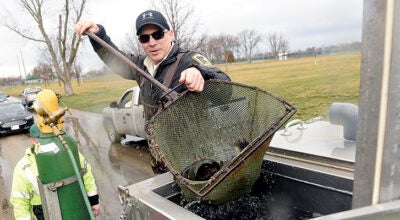Purple martins making a comeback
Published 7:26 am Thursday, July 8, 2010
This spring, when Izaak Walton League members looked in on purple martins that nest near East Side Lake, they found about 20 of the birds sick and shivering, in a single nest box. When they looked in again Wednesday, they found about the same number of birds huddled together in several boxes — but they were not the unhealthy, cold, birds of May, but rather new, healthy, baby birds.
The local chapter of the Izaak Walton League, which maintains purple martin houses on the lake and in other parts of the city, lost dozens of martins to a cold and damp spring this year.
They were relieved this summer, said member Bob Goetz, to find 17 or so nesting pairs at the lake. Goetz and his grandchildren tended to the birds Wednesday while Dick Smaby banded the legs of 23 of the newly-hatched.
Smaby, who also does banding at the Jay C. Hormel Nature Center, said this is the second year he has banded nestlings — baby martins — at the lake.
“This is so we can see how many survive, how many come back here; I don’t think any came back last year,” Smaby said.
Wintering in Brazil, purple martins migrate to North America in the spring to breed, according to The Purple Martin Conservation Association.
Martins, like all swallows, are aerial insectivores, eating only flying insects that they catch while in flight themselves. This makes martins vulnerable to weather conditions that affect insect availability, like rain. When poor weather persists for more than a couple days, martins begin to die of starvation — which is what happened at East Side Lake this spring.
“We want to rebuild the numbers. They have been at historic lows, and we want the populations to continue to an upswing,” Goetz said of the league’s work with martins which began in 2006.
Smaby put two bands on each bird that was old enough, one from the U.S. Fish and Wildlife Service and one from the Minnesota Department of Natural Resources.
“Each [band] has a unique number, it’s like a Social Security number,” Smaby said. “We just hope we can read them later with a ‘scope.”
A couple of martins were found dead in the nest boxes Wednesday, and one nestling seemed to be unhealthy and too small.
Having a few baby birds not make it wasn’t alarming to Smaby or Goetz.
“That’s the way nature is,” Smaby said.
For more information about purple martin conservation, go to purplemartin.org.



